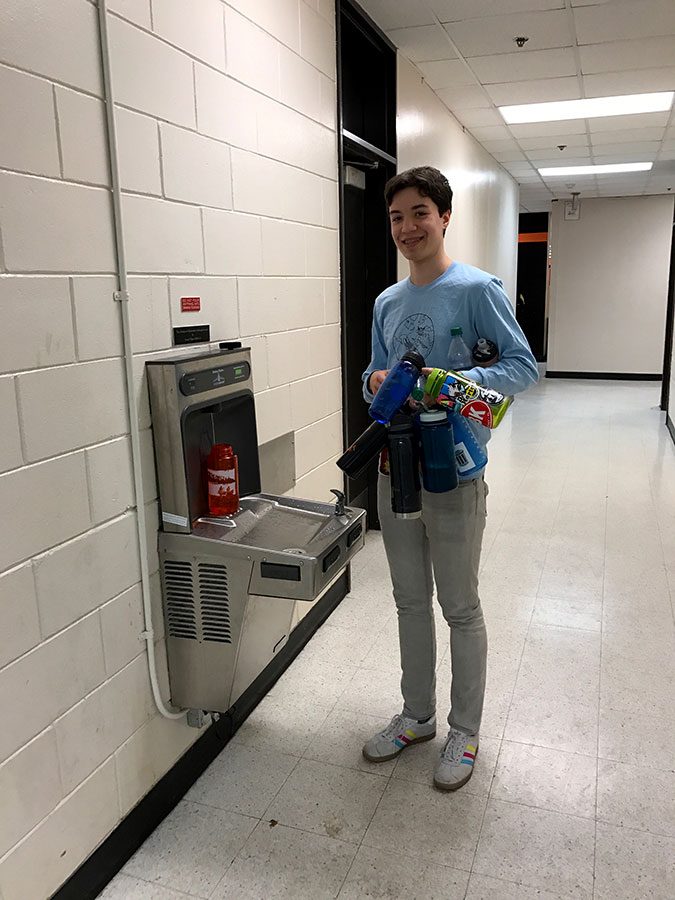H-2-Uh-Oh! Is South’s water going down the drain?
Junior Avery Hultgren makes the daily water run to the Station of Hydration for his classmates. While putting in these stations, some of the contaminating fixtures, aka the old water fountains, were removed. Because the Green Tigers made it possible for South to get three of these filtration stations, the rist of lead being in the water is lower than at the other, older, drinking fountains around the school. Photo courtesy of Aria Kressel.
Lead is a transition element, a soft metal. The chemical symbol, Pb, comes from the Latin word plumbum meaning soft metal. Lead is the reason plumbing is called plumbing, because the Romans used lead pipes for their water. In the lead pipe department, we haven’t made much progress since centuries before the common era, when the Romans drank from lead pipes.
Lead poisoning is incredibly serious; it has the ability to damage every organ in the body, and can cause developmental issues in children. Recently, there have been articles and reports by local news sources, like 5 Eyewitness News, discussing the concerns that are arising on account of the lead in the plumbing systems at many public schools in the Twin Cities area. South is one of them.
You might be familiar with lead from going to the gas station where you buy “unleaded gas.” For a while, lead compounds were used in gas to make car engines run more smoothly. Most cars don’t use it anymore because lead is a poison to humans and to the environment and it was accumulating in the air.
Another familiar substance that use to feature lead, is paint. Until 1978, it was legal to use lead in household paints. It was outlawed because as it chipped slowly and became dust in the corner, people would breath in the lead and even that small, particle sized, amount could cause harm when breathed in on a daily basis.
South biology teacher, Mick Hamilton, explained, “Long term exposure to lead is of biggest concern with children as lead can affect brain development.” This explanation makes the fact that schools have lead in their plumbing even more concerning.
“Lead can also cause issues with adults, but since the adult brain is essentially done developing, this specific issue is not as big of a concern. Lead poisoning can cause issues with kidneys and it can cause death,” said Hamilton.
Because of these lasting and dangerous impacts lead can have, we stopped using lead in gas and paint. That means that we don’t use lead in pipes too, right? Right. Ever since the ‘80s, lead has stayed out of the pipes and soldering in buildings. However, South High School was built in 1968.
The water supply for the Minneapolis Public Schools (MPS) comes from the City of Minneapolis. The City’s water is lead free, so when water tests positive for lead, it’s because of the piping or soldering in the specific building or water system. According to the Minneapolis Public Schools’ Chief Operating Officer, Karen DeVet, South is not at risk for lead poisoning.
Another fairly recent event extremely relevant to water quality is the Flint Water Crisis. In 2014, Flint, Michigan began using the, historically sub par quality, Flint River as their water source. The repercussions were life threatening when the water was improperly treated, and the piping it went through after contaminated it with lead. President Obama declared the situation as a “federal state of emergency.”
The Department of Environmental Quality was breaking federal law by not properly treating the water. The crisis lasted two years and the National Guard was brought in to distribute clean water to the people of Flint. Hopefully that gives you an idea of the seriousness of lead poisoning.
According to Lee Setter, Manager of the Environmental Health and Safety for MPS, the Minneapolis Public Schools haven’t changed their guidelines since the events in Flint because the system in place was already functioning to keep lead out of the water supplies at schools.
The original lead rules for our district date back to the mid 90’s. Setter explained, “The guidelines talk about in schools where we’ve identified where we have levels above 20, that we implement a corrective action that is primarily the flushing of the water on a daily basis.” As it turns out, those schools get the same treatment as South until the district finds it convenient to renovate the domestic water system.
The flushing process means that every morning, when the engineers get into the building they turn on the water and flush out all the lead that may have built up overnight. The longer water sits in contact with the lead, the more time the soldering has to contaminate the water.
“So that’s kind of the daily management of it, and secondary is the replacement of pipe. We do piping and fixture replacement. We do that where it makes sense and we can fit it into our budget. We’ve been slowly but surely getting the piping replaced,” said Setter. DeVet and Setter explained that their next piping project will be at Jefferson School on Hennepin.
Setter explained what it means for a water system to be risky, “The state guidelines identify 20 ppb as kind of the action level for schools.” Parts per billion (ppb) is the measuring system for lead. One part per billion is equivalent to one microgram per liter.
“The department of health has a guideline that schools follow for testing and flushing systems. They ask for us to test schools every 5 years,” said Setter.
Conveniently, South was tested for lead on March 1st. Even though none of the tested drinking fountains or faucets had more than 20 ppb of lead, the district decided to continue the “flushing.”
When DeVet was asked if we flush our water in the mornings because we have lead levels above 20 ppb, she said, “No you don’t. In fact the flushing is something we continue to do as a precaution as I said one of our highest priorities, and certainly for Lee [Setter]’s area, his highest priority is safety, so he continues to flush but your levels are well below the threshold for concern.”
Setter said that we know South has lead in it’s plumbing, and even though the day the water was tested the conclusions were below 20 ppb, South continues to take preventative measures just in case. We also don’t flush out faucets in science classrooms or anywhere people wouldn’t normally drink water, so drinking from those rooms is not advised.
“The best way to fix lead issues is to have filters in place where people are drinking the water and also where water is being used for cooking and so on. Running water to flush the lines and always using cold water for consumption are also good ways to ‘get the lead out,’” said Hamilton.
Most of the student body uses the Stations of Hydration provided to us by our Green Tigers. These water stations filter and cool the water but few water filters are certified by the National Sanitation Foundation (NSF) for lead filtration, so we don’t want to bank on the fountain itself to keep us safe from lead poisoning.
The engineers explained to me that they had to put up signs around the building that say to run the drinking fountain or faucet until the water is cold before you use it- just another precaution.
There are a lot of “precautions” happening in an attempt to keep us away from lead poisoning. The only way for schools to completely get rid of the danger of lead poisoning, and to conserve water, is to completely get rid of the plumbing systems that incorporate lead.
Pencils, paint, gasoline, piping, soldering, and lipstick: lead has been featured in tons of things we use on a daily basis. Though there are schools in the district who exceed the 20 ppb safety regulation, South isn’t one of them. To ease parents, students, and staff, all those water bottles we save while filling our Nalgenes at the Station of Hydration is not, in fact, affecting our brain development.
As for other Minneapolis Public Schools, risk levels may be higher, so it’s not an issue to be dismissed.
Evie Murphy-Wilson carries with her an air of grace. Maybe it’s her inquisitive eyes, her confident smile; or maybe it’s her hair, impeccably bunned...











